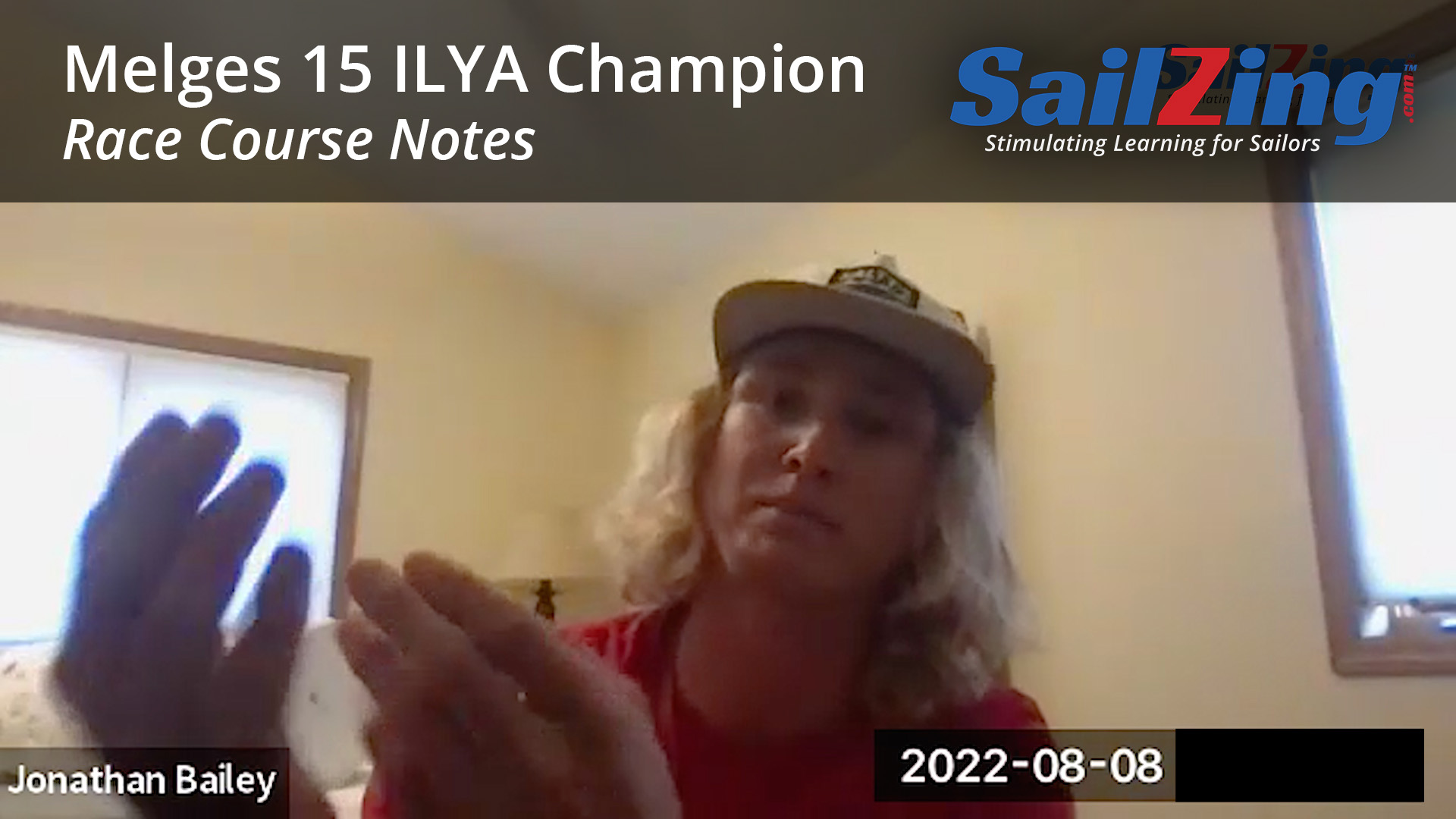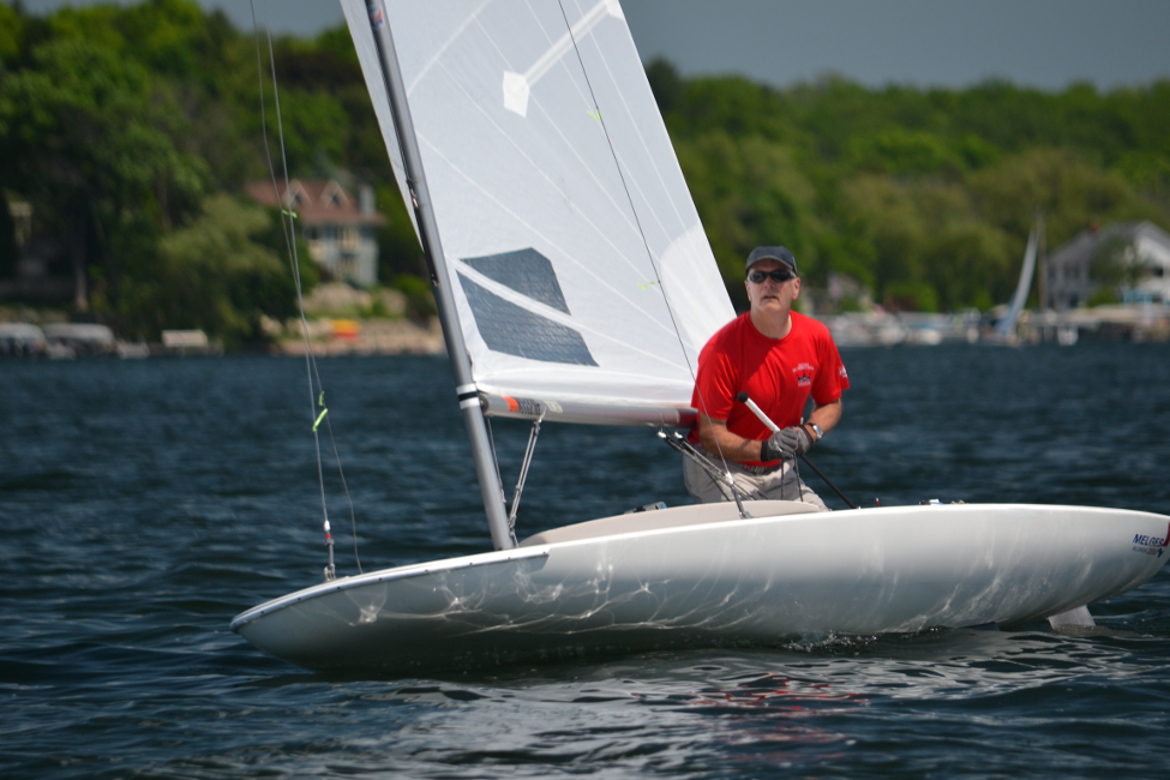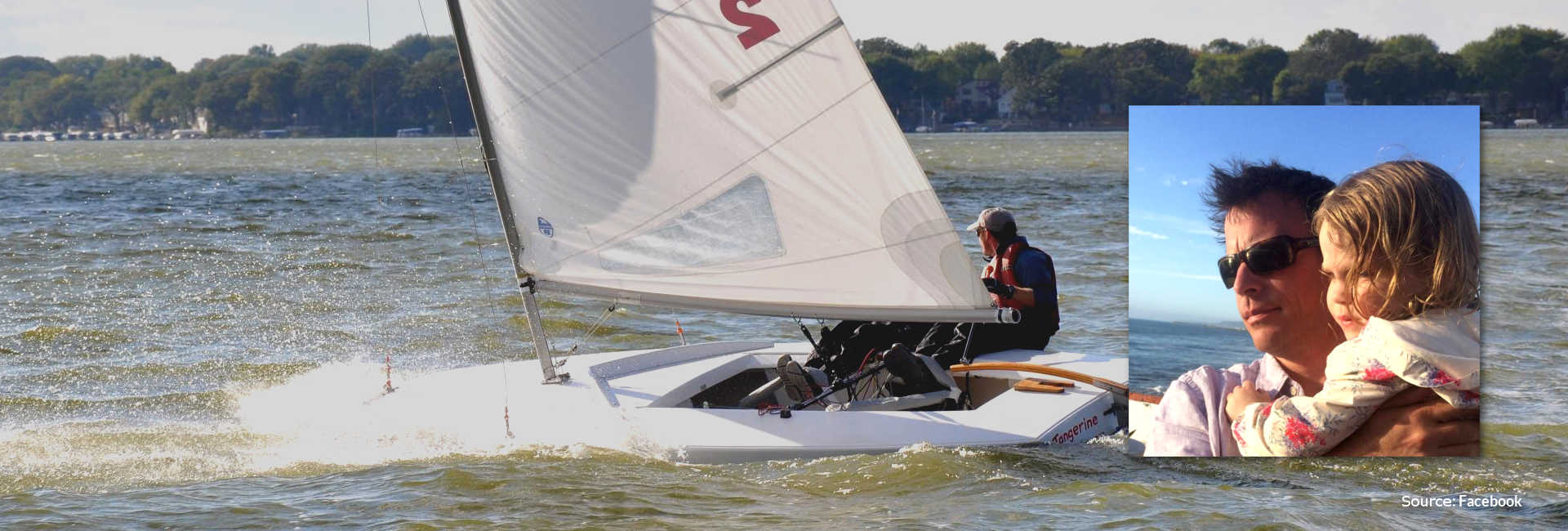We interviewed the winner of the 2022 Melges 15 ILYA Championship on Lake Winnebago – Jonathan Bailey from North Lake, WI (Suzanne Ackley – Crew) for his race course notes. This was the first ever Melges 15 ILYA Championship held since the boat, released in May 2020, became an ILYA sanctioned fleet in February 2022. The Melges 15 (M15) designed by Reichel/Pugh and built by Melges Performance Sailboats won the Sailing World Magazine “Boat of the Year” award in 2022.

Jonathan and Suzanne placed: 1 – 4 – NA – 6 – 1 – 1 – [11] for a total score of 24 and Net 13 after dropping the throw out race, 10 points lower than the 2nd place finisher.
We interviewed Jonathan from his home on August 8, 2022. The interview notes are paraphrased for space.
SZ: Congratulations on your win!! Tell us about yourself.
I grew up in Lake Country on North Lake, WI sailing Opti, X Boats, and then HS Sailing. …then Melges 17 for a while and sailed the 420 at Madison.
After graduating last year, I started sailing the E Scow at the helm. I prefer to drive.
SZ: What attracted you to the M15?
I just graduated from college and loved dinghy sailing – 420, FJs. The M15 is like a little bit more exciting 420…with a kite. Big roll tacks, big roll gybes…lots of hiking.
SZ: What did you have to learn in the M15 that was different?
The Chine. You want a little bit more heel in light air in chop. You still carry heel in 420s and FJs in chop, but you do want a little bit of that heel to get more surface out of the water and get more lateral bite.
Similarities with the 420 and FJs: Get your weight as far forward as possible, especially upwind. If there’s chop, then go as far as nosediving and then move back a bit. …in chops, you want a stable boat with the bow down.
SZ: What was the most challenging about the M15?
Definitely the light air. Light to medium air downwind where you can plane sometimes, but not very often. That was the hardest, probably for everyone.
SZ: How did you make the call whether to go for plane or not?
It’s kind of a “feel” thing. You feel the boat load up. You see a “shot” coming and you’re in a light air spot, so you’re in your soaking mode / low mode, weight far forward (crew in front of shroud, almost at jib). Skipper’s backside in front position, but legs pointing back to stern in skipper’s spot. As pressure arrives, let the boat heat up, trim the main a little, let the boat press and heal and then skipper hops to windward and flattens and scoots back to pop the boat onto a plane. Also, do that to try to surf when you can’t quite plane.
SZ: Have you sailed the M15 in a bigger breeze?
Yes. We sailed probably 5 hours in total across a couple of weeks and sailed in 4-18 (mph) breezes. In the big breeze, it rips, but you have to just scoot way back, especially in waves, so you’re not hitting the next one…driving and pumping through it.
SZ: On Lake Winnebago, you didn’t really get a chance to experience big waves there…this time.
Not much, it was 15-16 (mph) in the beginning on Saturday, so it was like planing the entire downwind and that was fun. There was enough chop that you had to drive through it. If you stuff it, you just drop off your plane and you go slow. You lose boat lengths!
SZ: Were you able to do “blow through gybes”?
If we’re planing, it’s blow through. I’d call a “skiffy” and then we would turn through it really quickly and try to get planing as soon as possible. Anytime that we weren’t planing going into the gybe, it was J/70-style – pre-trim, big roll, big flatten – kinetic gybe. So transitioning from one to the other and having that call and knowing that you have those two options…
SZ: Do you have terms that you use with your crew that you practice to speed communication?
We practiced in both (modes), but this regatta was the most sailing that we had done together in the boat…just calling a “skiffy” is so huge and calling it 15 seconds before it’s going to happen. As long as you’re not around other boats, you should have your game planned out and everyone should know what’s going to happen way before it’s going to happen.
Moves have to be well thought out. The same thing goes for a drop too. I’ll probably call the turn and the drop halfway down the leg. The game plan is there. It might change, but you should always be thinking about how you’re coming into the gate. If you’re crowded, you might want to try to get “course right” to come in on starboard, thinking ahead and communicating.
SZ: Describe what you needed to do with controls in this series.
Similar to the 420, you don’t really change the outhaul much. The amount you would change it is so small, you want from 1.5 – 3 inches between the center foot of the sail and the boom. The depth low is not bad, there’s not much “moment” on the sail, so it’s not that bad. The vang, when we were fully hiked and overpowered, you just pull it on and “vang sheet” and hike really, really hard. In the moderate stuff, we tried some different things. When it was choppy, sometimes it would feel a little draggy like the boat was going kind of slow. So sometimes we would pull on some vang and point lower to take some drag out of the boat. Definitely playing the vang for different pressure, but never too much. If you pull on too much, the sail gets really bad and it’s not good.
SZ: Did you handle the vang (GNAV) or the crew? (*GNAV is a vang that operates above the boom rather than below to provide more crew space below.)
The skipper should not be doing that. You need to be driving and sheeting. The crew does small changes. Just like in college, the crew is always on the vang. Sometimes, I’ll pop it off on the set at the windward offset rounding and once the kite is up, do fine tune adjustments, but that’s the only time that I would touch that.
SZ: What about use of the outhaul / Cunningham?
Big. Big. Super important. If you’re overpowered, it just makes your life easier. Just pulling that draft forward makes you have to sheet way less. It will depower the front of the sail way quicker, because the boom has to travel less of an angle for the sail to start luffing. So pulling that draft as far forward, you’re sheeting half the sheet to get the same effect out of your vang sheeting. It gives you more forward drive too in heavy air. More efficient. Less pointing, but more fast forward boat speed. Crank on that. If it’s “nuking nuking”, you can “banjo” it on – pull, slack out, pull as tight as possible.
SZ: Let’s talk about rig tension. How did you set your rig tension?
Our crew weight was 300 pounds. Our rig tension was 18.5 when the breeze was up, maybe blowing 15 mph. It will change based on your crew weight and how much vang you’ll be pulling on. The more you’re vanging, the more rig tension you’ll need. At full vang, you shouldn’t have your forestay collapse or “breaking” (bending).
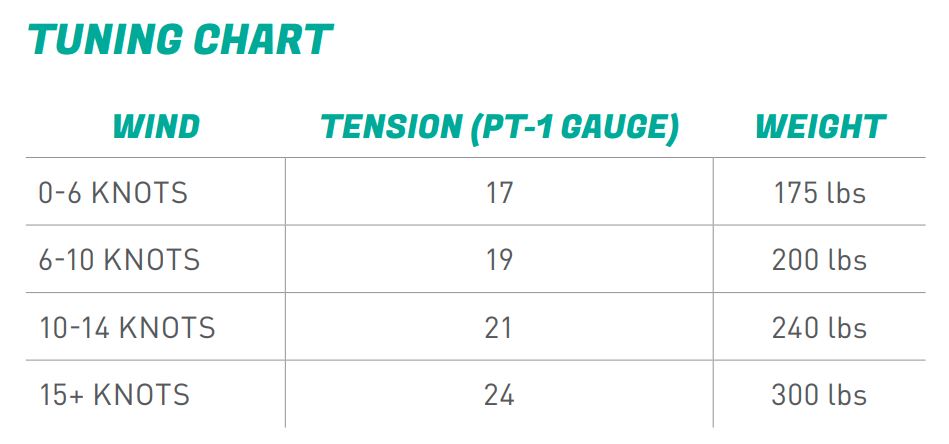
SZ: It was shifty on Lake Winnebago, what wind patterns were you watching for…?
The way the course was set, the wind was S-SW. There were some changes, but that was the main direction and shoreline effects, righties on the right side…more pressure. The main thing was finding your lane to sail to where you want to be. You need your lane,and if you don’t have your lane, tacking is NOT slow. Just tack and then tack back.
On the start too, stay out of trouble. Get off every time.
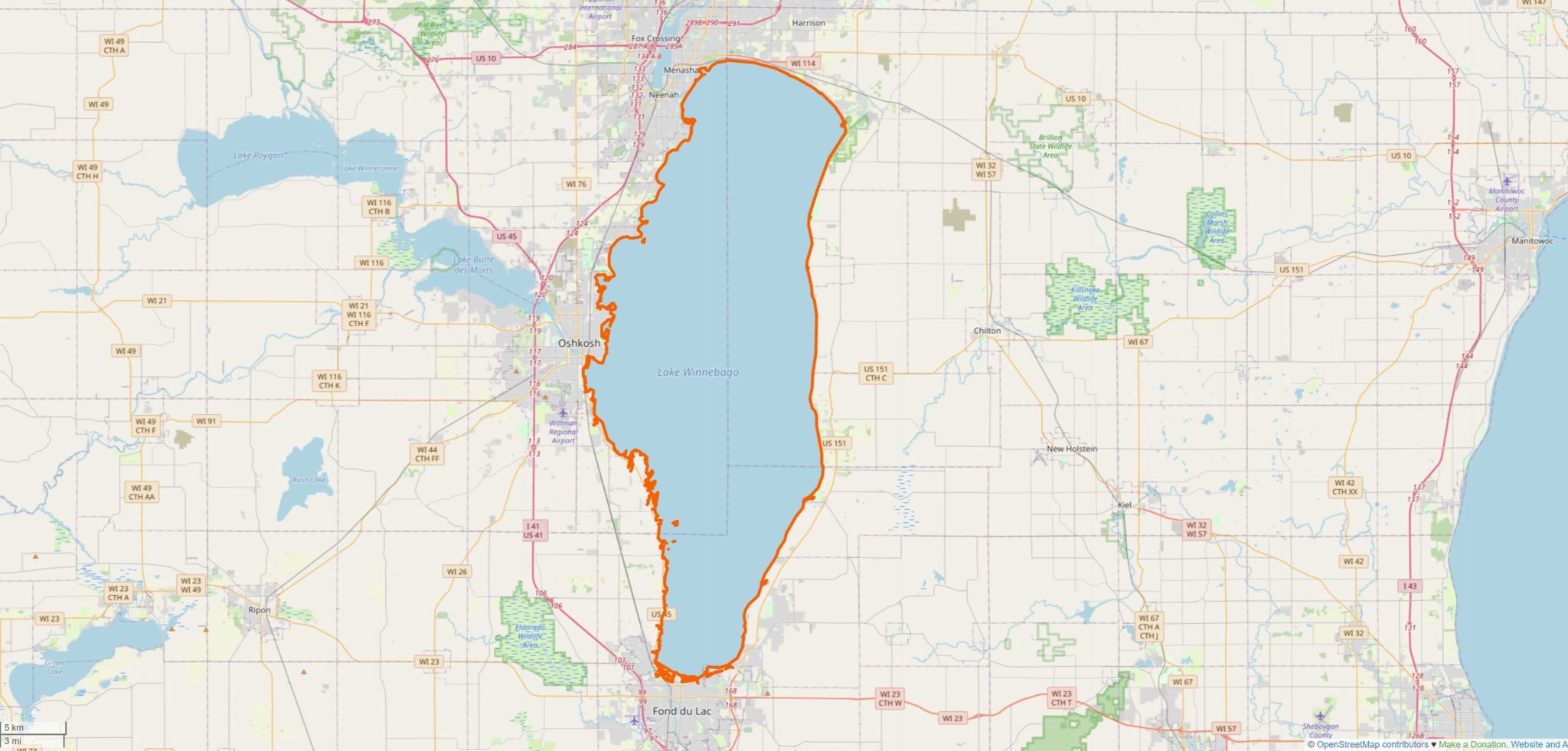
SZ: Dave Dellenbaugh says something like “Strategy is the race plan that you have absent any boats. Tactics are what you do when someone gets in the way.” How often were you able to stay on your strategy?
Yeah. Exactly. For the most part, it was strategy and speed. There was some tactical moding off the start. We wouldn’t pull vang on very hard and I’d trim really hard and just hike. We’d always start to leeward of the boat clump. So we just tried to pinch off as many of the boats until they all started going and then we would flop with them. We did that basically every single race and it was pretty bulletproof.
SZ: Do you have a preferred starting strategy…starboard or port end, port approach?
Love a good port approach, especially to get leeward of the clump, just out of the chaos, but close enough to where you want to be so you can get off every time. So, I think for the most part we’d cycle and then go back at about 1:45 or something and then tack into place at like 1:05 usually. Then go slow for the next 40 seconds of our spot and then the last 20 seconds get our speed going and point as high as we can and have our sails pulling and going really, really high and closing the gap. I’d try to have no hole for most of the minute and just make my hole by just accelerating and then shooting up…hiking really hard and rolling to windward and shooting up…to just get your hole when you need it, basically.
SZ: My experience in this fleet is that they can close a gap really quickly. So you delay creating your hole to leeward so nobody can get in there?
Yeah. So, just “eyes behind”, you know, because people are going to be coming from behind because the boat end is always super packed and people are always late at the boat. So they’re always coming through trying to get in. You just make it really unappealing.
SZ: Are you using any race computers?
No. Old school. No compass. No numbers. I’m sure it’s nice. I never sailed with them in my life.
SZ: Talk to us about line sights or knowing your distance to the line.
Basically just look over my shoulder and mentally draw a line. There’s a big line sag so you can know that the closer to the middle that you start and you can keep your bow there and just accelerate earlier. For the most part, we were close enough to an end (not at it), but close enough.
SZ: What would you say about tacking angles…similar to a 420 and what would you say versus an E Scow?
Definitely pretty similar to a 420, but I think a little wider than an E Scow. …but you have so many upwind modes to play with that they swing a lot. If you’re in your high mode, high and slow, you have 6 or 7 degrees to play with where the VMG is really equal. You basically go into your mode where like if there’s pressure over my shoulder we’ll go in high mode because if we stay in this we’re going to gain so much more. …or we go low mode out to the side because I know there’s a shift there and we’re trying to get there first. So the tacking angles can change, but it’s pretty wide, like a 420.
SZ: We heard a story about your crew, Suzanne Ackley, falling out of the boat right before the finish and she held on through the finish line before you could get her back in the boat.
<laughs> Basically, we were sailing… just trying to get this one position down to the finish line, “bow even” shooting down to the line. We had never done a downwind shoot like that so I don’t think that the communication was very good on my end about what was about to happen. So, it was a big turndown, she took a tumble, but uh, yeah.
SZ: She hung on with hands of steel, apparently.
Yeah. Kite sheet! …got her back in the boat.
SZ: Thanks Jonathan and congratulations!
SailZing.com would like to thank Jonathan again for sharing his thoughts on the Melges 15 and winning the inaugural ILYA Melges 15 Championship regatta!

